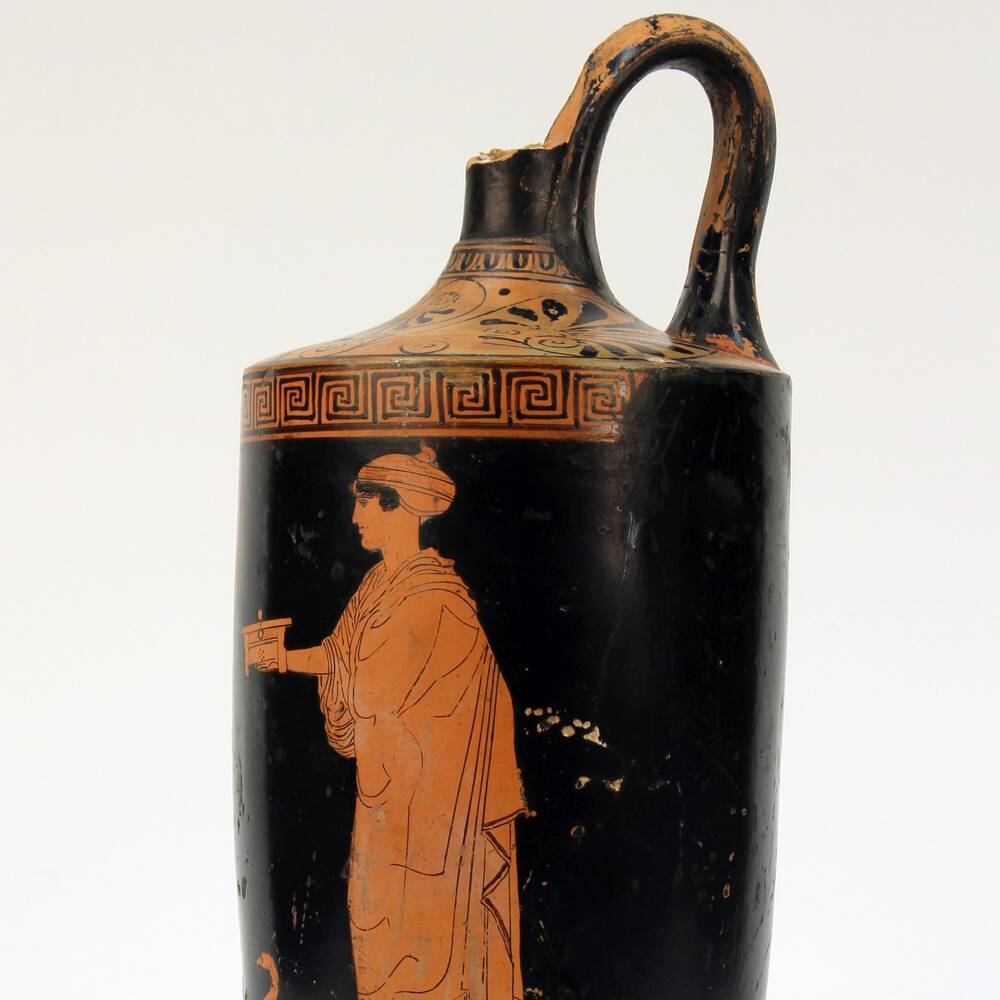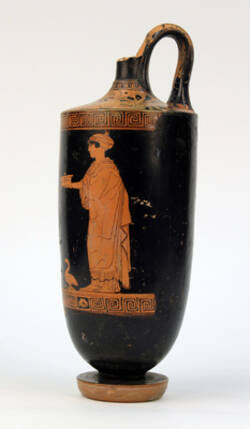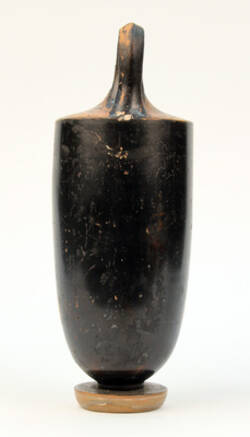These tall slim vessels for storing oil are known as lekythoi – or lekythos in the singular. The lekythoi had a standardised design, hardly varying down the years. But their decorations did change. On the oldest lekythoi from the sixth century BC, the figures appear black. Later, by reversing the black-figure technique, the figures became red in colour, as for instance on the lekythos with a meander motif. On that vessel, you can see a servant passing her mistress a small casket. The seated woman, wearing a diadem, is stretching out her hands and has her gaze fixed on a bird – a goose. In ancient Greece, the goose was one of the sacred birds associated with Aphrodite, the goddess of love. So could this little casket be a lover’s gift?
From the fifth century, there were also lekythoi with coloured painting on a white ground. These lekythoi were solely used in funeral rites and practices. They contained scented oils for anointing the body of the deceased and the grave. It was also quite common for the lekythoi to be buried with the dead person as a funerary sacrifice. The decorative scenes on white-ground lekythoi were often related to the deceased. However, they did not show naturalistic images, but calm, almost emotionless stylised figures. These burial vessels were prefabricated in large numbers in workshops so they were quickly available when someone died.
Further Media
Today, a vase is most commonly associated with flowers. But in the early 1700s, when the scholarship of Greek vases first developed, the word also referred to every kind of ancient pottery. As a result, the term ‘vase painting’ has remained a term used by experts in the field.
To imagine the omnipresence of pottery ware in ancient times, just think of our world with no glass or plastic containers, and no metal containers on ships, trains, or trucks. Imagine all those goods being transported in pottery vessels.
Of course, simple ceramic vessels for transport were not decorated. But, apart from those vessels, there were specially shaped and painted vases, in particular for religious or ritual purposes. Written sources from antiquity have given us many terms for the different shapes of vases, though as yet scholars have not successfully ascribed these terms unequivocally to the known individual styles.
Very few surviving vases are of such outstanding quality as those on show here. Nonetheless, for research, quantity also matters! Hundreds of thousands of painted vases have been and still are meticulously analysed and studied. In this way, we can gain detailed insights into local preferences, motifs, and technical developments – and even identify individual vase painters, either because they signed their works or have a distinctive style.
Red-figure vase painting – as it is known – which emerged in Athens around 530 BC, may well be the most significant stylistic development. Red-figure vase painting came from the ingenious idea of reversing the previous technique for black figures on a red ground. By leaving red areas unpainted, the figures took on the colour of the clay; the surrounding areas were covered with a slip which turned black when fired. The result: red figures on a black background. This new style was greeted enthusiastically, and suddenly only a few potters still continued the older tradition of black-figure vase painting. The trend to red-figure vase painting lasted several generations and is found well beyond Athens itself.
- Location & Dating
- c. 440 BCE
- Material & Technique
- Clay
- Dimenions
- H: 32 cm, Dm Mündung: 6,8 cm, Dm Schulter: 12,0 cm, Dm Fuß: 6,7 cm
- Museum
- Skulpturensammlung
- Inventory number
- ZV 2777



